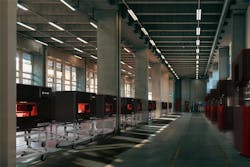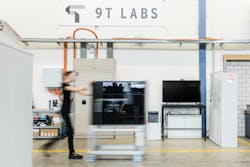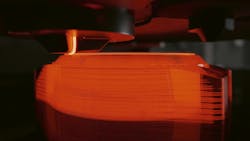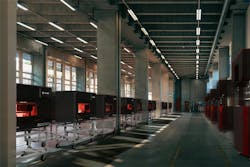Additive Fusion Technology’s Impact on Manufacturing
In the world of additive manufacturing, additive fusion technology (AFT) is helping to turn design concepts into tangible products swiftly and sustainably. A key player in this realm is 9T Labs, a Swiss startup co-founded by its CEO, Martin Eichenhofer, and which specializes in continuous fiber components that yield robust and lightweight products.
AFT integrates software, materials and hardware to automate fiber tape placement in additive manufacturing (AM) units, followed by consolidation in a fusion module, resulting in the final parts.
Material Selection, Placement
Material placement and post-print processing are paramount to AFT’s success. Using continuous fiber materials, AFT streamlines automated fiber placement and subsequent molding for consolidation, ensuring precise material distribution and adding to the final product’s quality, strength and versatility.
From PEEK to nylon, AFT can accommodate different materials, which allows for custom solutions that can meet specific application requirements. While polymers are mainly used in the additive step, the molding phase in AFT enables the mixing of different materials, including metals, to enhance functionality and design possibilities. “We really are agnostic when it comes to materials,” Eichenhofer said.
The adoption of AFT has shown significant advantages for applications that require metal substitution. By enabling the production of composite parts at scale, AFT addresses the challenges of technical feasibility and commercial viability associated with metal-to-composite transitions. Industries like aerospace and automotive benefit from AFT’s ability to produce lightweight, strong parts with intricate designs in a cost-effective and sustainable manner.
Additionally, complex geometries and intricate designs are efficiently handled in AFT through advanced engineering software, which allows for precise placement of continuous fiber tapes, optimization of material orientation and interaction with simulation tools for validation and optimization.
WATCH: An Overview of Additive Fusion Technology
The Manufacturing Process
A comprehensive process that involves multiple key components and stages to go from input data to the final printed object, AFT begins with selecting high-quality materials, such as continuous fiber tape, which are made accessible for technology integration.
Next, the software aspect plays a crucial role where full material data cards are utilized to understand the characteristics of the selected materials. Engineering software like Fibrify Design Suite is used to create highly optimized parts by placing continuous fiber tape materials or short fiber reinforced polymers, according to Eichenhofer. He noted that while the engineering software is currently local-based, providing a comprehensive platform for lightweighting and cost-effective design optimization, AFT’s future roadmap may include cloud-based solutions for enhanced collaboration and workflow management.
By rewriting the thermal history of the material through all the steps in AFT, properties like surface finish, interlaminar bonding and porosity are improved significantly, Eichenhofer said, adding that the fusion step is crucial in addressing interlaminar bonding issues and enhancing the overall quality of the final product.
The entire AFT process involves two main machines for placing the material and molding it, with the curing (solidifying) happening in both steps as the material goes through the melting and reshaping processes. The iterative process of melting and reshaping the material does not degrade its properties if proper controls are in place to maintain material integrity throughout the process. This approach in AFT minimizes the challenges often associated with 3D printing, making it an efficient and effective method for producing high-quality, functional parts, Eichenhofer explained.
WATCH: A Deep Dive into Additive Fusion Technology
Overcoming Challenges
The technology is not without its challenges and limitations. These include fragmentation, different technologies, a range of vendors and being a comprehensive solution for the entire process from idea to final part production. “Part of the challenge is that...it’s very fragmented, very different technologies, very different vendors, and the first point is being a solution [as opposed to] one element,” Eichenhofer said. “Just the software, just the hardware, just the polymer materials, the composite materials.”
The complexity of composite materials is a challenge, he added, as optimizing fiber orientation requires good material data cards and validated simulations.
In the future, 9T Labs sees a breakthrough in the industry with the potential for additive manufacturing technology to produce parts at scale, beyond just prototypes, jigs and fixtures. This production at scale, combined with molding and the right applications, could change the perception of what can be done with composites.
Examples of advancements in the software stack could include greater intuitiveness and ease of use, enabling engineers to work with complex materials and tasks. Application-wise, 9T Labs aims to show improvements in performance vs. weight, with composite materials offering strength gains of up to four times compared to metals, Eichenhofer said, even while reducing weight by half.
He emphasized that sustainability is an essential factor for 9T Labs. The company is using thermoplastic materials which can be remolded and remanufactured multiple times, thus closing the circularity loop. “The recycling has a clear cost benefit…and, in general, customers ask for a solution that has an end-of-life solution,” Eichenhofer said. This approach reduces the CO2 footprint of composite materials.
WATCH: Additive Fusion Technology: Overcoming Challenges, Looking Ahead
AFT at a Glance
At 9T Labs, additive fusion technology (AFT) is an innovative approach to additive manufacturing that addresses challenges in composites production. Its key components and stages include:
Material Selection
- AFT begins by selecting high-quality materials, including continuous fiber tape.
- These materials are then made accessible for technology integration.
Software Aspect
- Full material data cards are utilized to understand material characteristics.
- Engineering software, such as Fibrify Design Suite, optimizes parts by placing continuous fiber tape or short fiber reinforced polymers.
- This software enables the creation of hybrid, high-performance parts validated using tools like ANSYS, Nastran and Abacus.
Manufacturing Process
- Engineered parts move to the Fibrify Production software, connecting engineering software with hardware.
- The process involves two main steps: Additive Manufacturing Step (Build Module)—precisely lays up material following engineering specifications. Fusion Step (Fusion Module)—equipped with an electrically actuated press, it compacts the material preform in a mold, ensuring quality and functionalization.
- The rigid tooling metal mold (often steel) shapes the final product and fuses different materials together.
Thermal History Rewriting
- Remounting material in both additive manufacturing and molding steps solidifies it without traditional curing.
- AFT rewrites the material’s thermal history, enhancing its properties.
About the Author
Sharon Spielman
Technical Editor, Machine Design
As Machine Design’s technical editor, Sharon Spielman produces content for the brand’s focus audience—design and multidisciplinary engineers. Her beat includes 3D printing/CAD; mechanical and motion systems, with an emphasis on pneumatics and linear motion; automation; robotics; and CNC machining.
Spielman has more than three decades of experience as a writer and editor for a range of B2B brands, including those that cover machine design; electrical design and manufacturing; interconnection technology; food and beverage manufacturing; process heating and cooling; finishing; and package converting.
Email: [email protected]
LinkedIn: @sharonspielman
Facebook: Machine Design
YouTube: @MachineDesign-EBM




